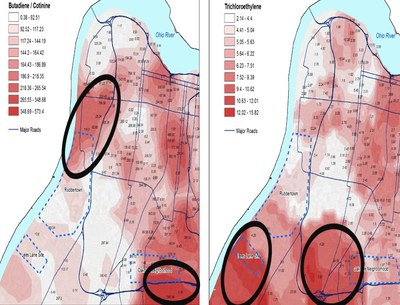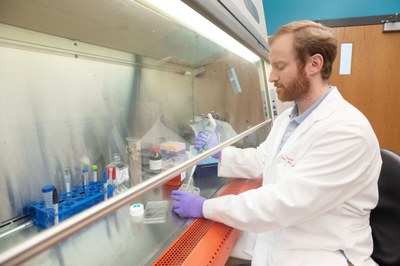Projects
Project 1 - VOCs and Cardiometabolic Injury
The overall goal of this project is to assess the impact of exposure to Superfund-relevant volatile organic compounds (VOCs) on cardiometabolic disease, the underlying conditions that contributes to diabetes, cardiovascular and liver diseases. VOCs such as trichloroethylene, benzene, acrolein, formaldehyde, xylene and butadiene are major chemicals of concern at most Superfund sites and extensive previous work suggests the exposure to VOC could have a variety of adverse health effects. Nevertheless, whether exposure to VOCs at levels relevant to neighborhood adjacent to Superfund sites could adversely affect cardiometabolic health remains unknown. We are testing the hypothesis that exposure to VOCs exacerbates/induces vascular and hepatic dysfunction leading to a cascade of events that increase CMD risk. To assess the impact of VOC exposures, we will examine 1200 residents of Jefferson County, including those who live in areas adjacent to Superfund sites such as Lee’s Lane and Distiller Farm, as well as high VOC emission, such as the Rubbertown neighborhood. In each participant, we will assess CMD risk by measuring arterial stiffness, marker of hepatocyte death, as well as suite of biomarkers indicative of risk for diabetes, cardiovascular and liver diseases. To determine population-level VOC exposure and its relationship with CMD-related hospital admissions and mortality, we will establish a network of VOC monitors to measure VOC levels throughout Jefferson County and monitor domestic wastewater for urinary VOC metabolites. We will monitor wastewater every other month for 4 years and assess the extent to which population-level exposure estimates reflect ambient air VOC levels and individual-level exposure (Aim 1), and how these estimates relate to population-level and individual-level CMD risk. To obtain longitudinal data, we will examine CMD progression and determine the association between individual-level and community-level VOC exposures with vascular and hepatic function and other indices of cardiometabolic risk. This will help us in assessing how VOC exposure and/or residential proximity to Superfund sites affects the risk of CMD and this excessive risk differs from that imposed by background VOC exposures in urban neighborhood. See Project 1 select publications.
Project 2 - Molecular and Cellular Mechanisms of Cardiometabolic Toxicity of VOCs

Exposure to toxicants has been linked to the development or exacerbation of chronic disease. However, little is known about how volatile organic chemicals (VOC)—a class of toxicants associated with higher prevalence of type 2 diabetes (T2D) and stroke—promote the development of cardiometabolic disease (CMD). Accordingly, the overarching goals of this Superfund project are to determine the mechanisms by which VOCs negatively impact cardiovascular health and metabolism, identify biomarkers for VOC exposure and vascular injury, and test therapeutic strategies to minimize VOC-induced CMD. Our studies in the current funding cycle and preliminary data suggest that VOC such as benzene, vinyl chloride, and crotonaldehyde promote endoplasmic reticulum (ER) stress and trigger the unfolded protein response (UPR) in endothelial cells. Specifically, we hypothesize that aldehyde metabolites of VOC, which are generally more toxic than their parent compound, diminish endothelial toxicity by inducing ER stress, which triggers metabolic changes that accelerate ectopic lipid deposition and promote cardiometabolic dysfunction. To test this hypothesis we will: (1) examine the effects of VOC exposure on endothelial function and insulin resistance; (2) delineate the contribution of protein misfolding to the cardiometabolic toxicity of VOC. The design of these studies includes molecular and pharmacological interventions designed to detoxify or quench the reactive intermediates evoked by VOC exposure as well as studies that could lead to the identification of novel, sensitive and robust biomarkers of both VOC exposure and vascular injury. These studies were designed to synergize with and provide biological plausibility for the associations identified in Project 1. Successful completion of this project will lead to identification of the underlying cellular and molecular mechanisms by which VOC affect cardiometabolic function and provide insights into how VOC toxicity could be prevented or therapeutically minimized by targeting aldehydes or proteinfolding pathways. See Project 2 select publications.
Project 3 - Development and field application of novel ultrasensitive devices for the measurement of airborne VOCs
This proposed work is to advance airborne volatile organic compound (VOC) detection and quantification technologies, and to robustly characterize indoor/outdoor contrast and in-home determinants for exposures to target Superfund-relevant VOCs. This research will continue to grow and expand two VOC real-time in situ measurement platforms developed by the University of Louisville Superfund Research Center established in 2017. One platform comprises small, low-cost sensors that can be deployed alone or in networks. Novel gas sensors and sensor arrays are being developed to measure target Superfund-relevant VOCs including acrolein, trichloroethene (TCE), benzene, toluene, ethylbenzene, and xylene (BTEX). The devices use novel surface chemistries to address the common challenges of selectivity and sensitivity and are fabricated using microelectromechanical systems (MEMS) technology. Another platform addresses the need for flexibly designed, field-deployable instruments that can measure with high sensitivity a large range of compounds to interrogate microenvironments with complex VOC mixtures. The Multichannel Organics In-situ enviRonmental Analyzer (MOIRA) instrument, developed in the first cycle of Center funding for mobile monitoring, will be expanded and optimized for indoor/outdoor VOC monitoring studies. MOIRA is a gas chromatography–mass spectrometry (GC-MS) instrument with high time resolution (e.g., ten minutes). Its capabilities will be expanded to measure both higher and lower volatility compounds than can be achieved with the current design. These innovative, high time resolution in situ measurements will be coupled with conventional time-integrated VOC passive sampling to measure target Superfund-relevant VOCs at homes of some participants in the allied clinical study. These data will be used to build spatiotemporal models to estimate ambient VOCs at the homes of all clinical study participants, and to gain new insights into VOC levels and their determinants in the home microenvironment. In addition to exposure assessment, the two measurement platforms are responsive to ongoing Superfund program advancements; these innovative developments will expand future capacities to monitor VOC indoor vapor intrusion, monitor outdoor VOC levels during site remediation, and monitor both indoors and outdoors during post-remediation surveillance. See Project 3 select publications.
Project 4 - Advancing VOC Treatment with Novel Materials and Processes
Volatile organic compound (VOC) exposure increases the risk for a variety of adverse health outcomes, including cardiometabolic disease (CMD). VOC management, including remediation, is thus necessary to mitigate exposure and thereby adverse health outcomes. Within the University of Louisville Superfund Research Center’s overall mission, the primary goal of Project 4 is to develop and demonstrate novel, material-driven processes for new VOC treatment strategies and technologies to meet the challenge of the complicated nature of VOC occurrence and exposure. Towards this goal, Project 4 aims to achieve broad-based VOC treatment capacities, in both the gas and liquid phases, with high efficiencies, flexible operation, low energy inputs, no chemical additives, and no harmful products. We propose an innovative, three-pronged (as Project Aims) project structure, focused on materials that are capable of harnessing various irradiation energies (e.g. solar irradiation, microwaves) for broad VOC treatment. Specifically, three integrated Project Aims are designed to: 1) Develop and demonstrate a unique class of hyperthermic nanomaterials, defined by their capacity to emit (localized, surface-based) heat when subjected to microwaves, effectively acting as energy ‘antennas’, to generate extreme, surface localized heat gradients for thermal treatment of VOCs; 2) Develop and demonstrate metal/oxide hybrid materials to achieve synergistic photothermocatalytic effects for oxidative VOC degradation at significantly reduced temperatures (even room temperature) compared with conventional thermocatalytic oxidation; and 3) Develop and demonstrate 3D, crumpled graphene oxide (CGO) composites as a material platform for improving performance, and in some cases underpinning novel (re)design strategies, for membrane-based (flow-through), photo-enhanced VOC treatment. Upon the successful completion of the Project, newly developed materials, technologies, and processes as well as fundamental insights will directly advance VOC treatment paradigms, leading to better VOC exposure management strategies and thus potential health benefits. See Project 4 select publications.
